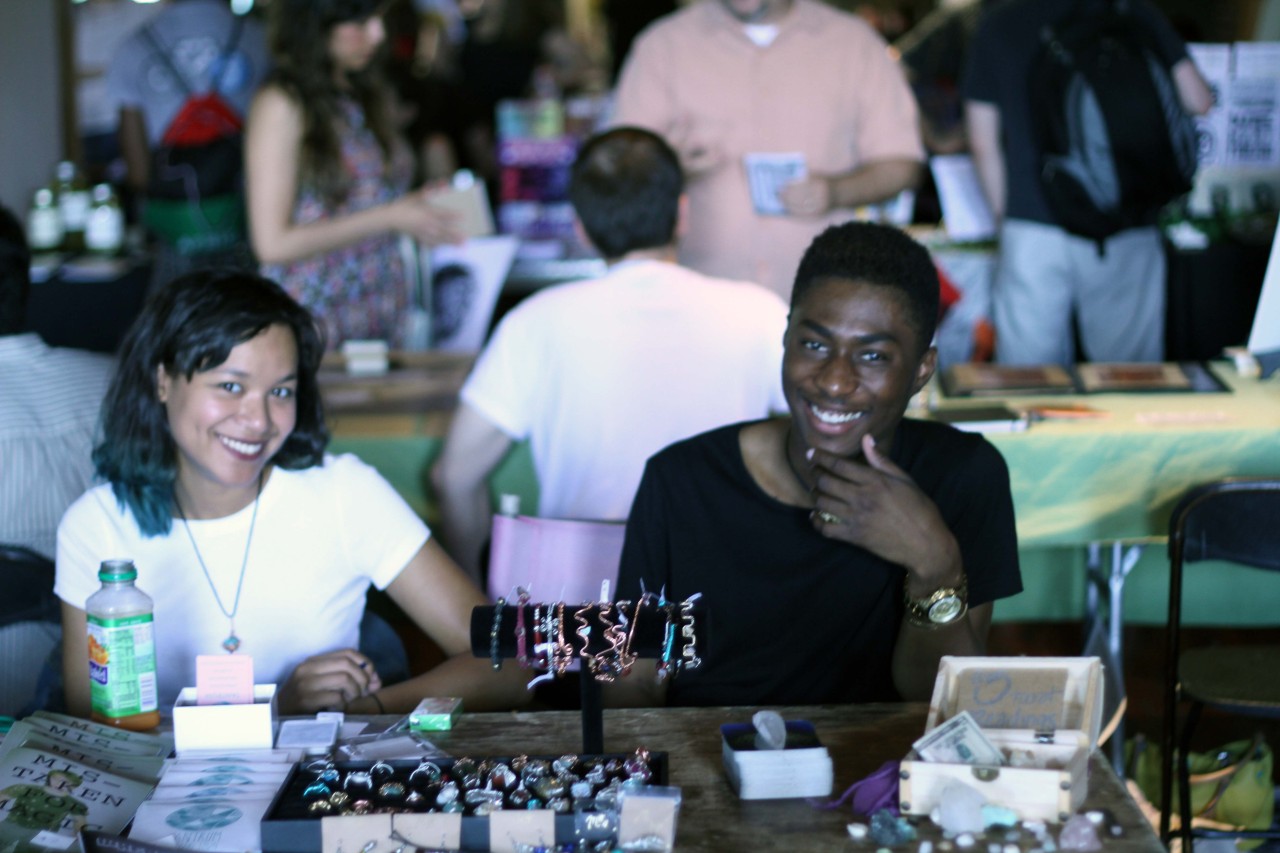 Photo by Thomas Fine
Photo by Thomas Fine
Do-It-Yourself in the Digital Age
By Hira Mahmood
The Atlanta Zine Fest is an annual conference celebrating DIY and handmade media. The first Atlanta Zine Fest, held in 2013, garnered over 300 participants, 25 vendors, and 21 speakers/workshop facilitators. AZF holds events and programs year-round, culminating in a one-day exhibition. This year, AZF has a variety of speakers discussing a range of topics such as “Deep Topics for Small Pockets: Using Zines to Discuss Death and Dying,” “Intersectionality and Urban Culture,” and “Disability and DIY Spaces.”
“In the first year, we just wanted to see if we could pull it off,” says founder of AZF Amanda Mills. “Now that we showed that we could do it, we definitely wanted to be more expansive and reach out to out-of-state speakers and vendors.”
In the broadest terms, zines (short for “magazines”) are self-published, small-circulating books, papers, or journals. Zines can be about anything and everything, and their topics are often too controversial for mainstream publishing. Zines first made their headway in the 80s and 90s as an exploration and development of the politics in punk and riot grrl scenes. Gender, sexual violence, capitalism, music - these topics not only made their way into zines themselves but also, as a result of their distribution, permeated alternative youth culture.
But we’re in 2014. Typewriters, handwriting, Scotch tape, Xerox machines, and vibrantly political punk scenes seem like things of the past. Now that we’re taking videos of the punk show on our smartphones and reblogging quotes on Tumblr, what can zines mean for us now? Are zines yet another commodification of nostalgia, mere relics of a more meaningful era? Is the low-culture love for zines a symptom of their recent recognition in high art galleries? Or, now that we’re in the blogging era, could zines and DIY culture be an insistence on sharing the ideas, emotions, and sheer tangibility we’ve lost between text messages?
SITUATING OUR CONTEXT
I sat down with a few people working and participating in AZF 2014 to get a better sense of how to situate the festival in terms of the digital age. The first person I spoke to was Katherine Paist, writer, author, and distributor of the literary theory zines “HYPOLOGIA” and “GHOST CULTURE.”
What brings you to AZF?
Katherine Paist: I think it’s really important to breach digital acquaintance and affiliation and bring people back into reality. I think our generation is playing a role in its own alienation. It’s a paradox. We are alienated from each other - we’re “friends” with people on the internet who we don’t even interact with in real life. We need to break that ‘blogosphere barrier,’ I guess. I want to do something not digital.
So what are you trying to accomplish by having this experience of sharing zines outside of the internet?
I can print out copies of what I wrote and have these conversations in real life. The sharing of ideas is really important - I feel like zine fests are easily reduced to an artistic aesthetic rather than a political commentary, but the political commentary is still there. That commentary, to me, comes through when we have these real-life conversations. Although some people might see DIY events as problematic because of their separation between the aesthetic and the political, events like AZF also play a huge role in merging aesthetics and politics and providing space for generating conversations.
Producing and exchanging things over the internet - it’s still awesome - but I see zines as a good attempt for people to hold onto the meaning of, “What did I do before I had a computer and the internet? How did I play outside with my friends for 8 hours without getting fucking bored?”
THEN AND NOW
After talking to Katherine about the existence of zines in the digital era, I wondered what kinds of commentary events like AZF provide on digital reproduction in the age of late capitalism. The pre-blogging era of zines carried a political undertone out of necessity - small-scale writing and publishing happened because the content of zines had little legitimacy in the mainstream capitalist environment of the 90s.
That same environment persists now, but the coherence of the 90s youth subculture in music, politics, and zines feels like a stark contrast to the hyper-circulation of culture allowed for by the internet now. Images are not only duplicated, but manipulated, offering a ‘second-hand truth’ disallowing us to experience authenticity (Baudrillard, “The Precession of the Simulacra”).
For the alternative culture of the 90s, the enemy was clearly identifiable: the suit-wearing bourgeoisie who are aliens from another planet in the cult classic They Live; apathy, police brutality, and misogyny confronted in the abrasive lyrics of riot grrrl bands (BratMobile to Bikini Kill). Effectively, the alternative music of the 90s drew out lines of demarcation - the “here’s us and there’s them.”
Something’s changed. The easy transmission of information via the internet and social media has effectively divorced our cultural engagements from the meaning – politics, feeling, real-life interaction – behind them.
We had this and Katherine’s points in mind when I interviewed Pastiche Lumumba, the executive director of The Low Museum, “a space dedicated to the critical engagement of contemporary culture through discourses on new media and underrepresented perspectives.”
Could you explain a little bit about your own artistic perspective and how it relates to why you are here at AZF?
Pastiche Lumumba: Zines are independent media. They are unencumbered by external influence. As they relate to our digital landscape, zines offer an alternative to the stories that broadcast on our news feeds. This is important because the feed stories are increasingly narrowing the sandbox of the internet by targeting netizens based on their search terms and browsing history.
It sounds like you see the internet, or our participation with the internet, as insidious.
What used to be an environment of exploration of new ideas has become a feedback loop that resembles the original sandbox. Zines that exist IRL are specifically targeted to an audience and eventually proliferates through hand-to-hand transmission. The personal attachment that we lose on the internet is maintained in zines.
How do you see zines in relation to your own work, curating the Low Museum?
My work involves filling gaps in cultural representation. Due to a variety of factors, certain voices are not heard, or compartmentalized, within traditional media outlets. Zines are accessible in their production and consumption, which makes for the exposure of important alternative voices and ideas.
HOW THINGS HAVE CHANGED
Both Katherine and Lumumba seem to agree that zines are a way of making real ideas and feelings heard in a context when they otherwise wouldn’t be. For Lumumba, this is more of a matter of mainstream media; while for Katherine, it’s more a matter of real life interaction (though Lumumba mentioned that, too). In any case, the internet seems to be the cause of a lot of loss.
So it would be easy to say that the internet has defeated a “pure aesthetic” and that the sharing of zines and ideas is now occurring in vain. But despite how alienated I feel from friends on Facebook and Instagram, there’s something to be said about the shared experiences of our demographic – and I don’t know if I can name it. My conclusion here is a little more hopeful: I believe that the insistence on tangible cultural objects in the context of a “real life” festival is evidence of a generalized grasping for meaning. We can see this shaping in other ways, such as the massive youth uprisings in countries hit much harder by the 2008 economic crisis than we in the U.S., and it’s harder to identify for us because we’re in the belly of the beast.
Let’s move forward - like the working class bohemian youth culture, the nascent intelligentsia that has accumulated $865 billion in debt after attaining a degree, the off-the-grid anarchist, queer insurrectionist, worker, artist, and inject meaning into our work, our daily interactions, and ultimately, ourselves.
Diggin' what you're reading? Then support this young writer by donating to {Young}ist now!
Hira Mahmood
Hira Mahmood is another peon with a literature degree, now pursuing an M.A. in Women's, Gender, and Sexuality Studies in Atlanta, GA.
Catch up with me @HiraMahmood5.

